It’s a strange but true thing that one of the last real muscle cars was – here it comes – a Buick.
The 1973-1974 Century GS Stage 1 455.
You have probably never heard of it – even if you are a car guy. Even though Buick sold more of them than Pontiac did examples of the much-better-known 1973-’74 Super Duty Trans-Am, the car that usually gets the honorific, last of the line.
The Century never got the attention it deserved, then – or now. 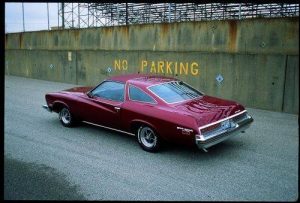
But it was what Mark Twain might have called a sockdollager. Maybe even more so than the ’73-’74 SD-455 Trans Am since the Stage 1 455 was, arguably the last real muscle car.
This is not to disparage the Trans-Am. It is merely a point of order.
The Trans-Am was, technically, a pony car – an emulator of the Mustang, which was the progenitor of that branch of the American performance car family tree. These cars still exist – including, of course, the Mustang as well as its Chevy nemesis, the Camaro.
Pony cars are smaller cars. Compact-sized four-seat coupes.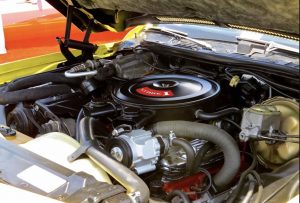
They seat two realistically, four excruciatingly. The back seats are there but only just barely. Legroom’s absence is only part of the problem. The pony car’s lower – and usually sharper – roofline leaves scanty headroom for the unfortunate who attempts to sit back there, which sitting is more accurately described as assuming the form of a person performing a cannonball off the diving board at a pool.
Legs and head tucked.
There is also essentially no trunk. A ’73’-74 Trans-Am had less than 9 cubic feet of space back there, most of it consumed by the spare – which wasn’t even a full-sized spare. The Trans-Am was a wonderfully impractical car – which may explain why Pontiac sold fewer ’73-74 SD-455 Trans-Ams (1,195 total) than Buick sold Century Stage 1 455s (1,206 total) over the course of these cars’ two-year parallel production run.
The Century was an intermediate-sized car. A full-size car by – modern car standards. It was 207.4 inches long and rode on a 112-inch wheelbase. That made it exactly as long overall as a 2020 BMW 7-Series, one of the biggest new sedans on the road today.
And the Stage 1 455 was a coupe.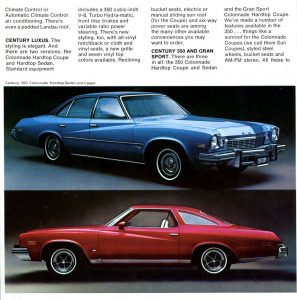
That was the muscle car archetype. A big car -with a bigger car’s engine. And the Century Stage 1 had that, too. Four hundred fifty five cubic inches, matching the displacement of the 455 in the ’73-’74 Trans-Am.
And almost matching its horsepower.
The Buick 455 made 270 horsepower and 390 ft.-lbs. of torque in 1973 vs. the SD-455’s 290 horsepower and the same 390 ft.-lbs. of torque.
In both cases, these were big numbers for 1973-’74, just before the advent of catalytic converters in 1975 and after that, not much more than 200 hp in any car for a long time to come.
Pontiac got lots of press for its ballsy decision to produce and offer for sale a new high-performance engine in the Trans-Am at a time when “performance” had become almost as politically incorrect as the showing of one’s face today.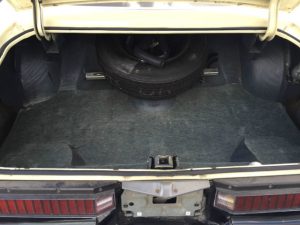
Buick got almost none – despite its arguably even ballsier decision offer the Stage 1 455 option, which included heads with larger intake and exhaust valves, a performance camshaft, dual exhaust and a dual-snorkle air cleaner ducting air to an 800 CFM Rochester Quadrajet four-barrel carb – underneath the hood of what had the gentle look of grampa’s car.
You could pair all that with a Muncie M21 manual transmission, too.
Imagine that. A coupe the size of a current full-sized sedan with a four-speed Hurst shifter in between the front seats. Or, not – if you chose the THM400 automatic and three-across bench seat.
With room in the back seats for three more of your lucky friends for six, all told – and a trunk big enough to hold a keg.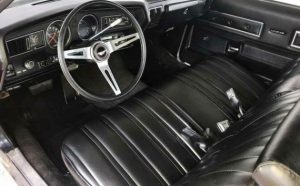
All of that supported by a full-perimeter steel frame onto which the body was bolted, with rubber biscuits sandwiched in between to isolate road shock and deliver that sofa-on-wheels-experience only a big car can deliver.
That was the muscle car formula and Buick did it up – and did it with air conditioning (which not many muscle cars had) and the usual Buick levels of comfort and refinement. It was not only the last muscle car, it was arguably one of the very first luxury-sport cars, too.
But it has faded into the mist of time and after almost half a century, almost no one knows it ever existed – perhaps because its existence was so brief. The Trans-Am SD-455 was discontinued after 1974 because that engine wasn’t compatible with catalytic converters – or the political climate of the times. But the Trans-Am itself continued in largely the same form through the 1981 model year and became hugely popular during that period in part because of the Smokey & The Bandit movies but also because after 1975 there was practically nothing left that even looked like a performance car, let alone performed like one.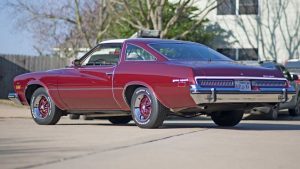
Buick retained the “Colonnade” coupe styling penned by Bill Mitchell for another three years -and the look arguably worked better with the federally-mandated “5 MPH bumpers” that marred the look of the Trans-Am, which had been designed earlier and thus looked as if the heavy bumpers had been tacked on after the fact, which they were – as opposed to integrated with the shape, as the Buick’s were.
Plus, the big chromed bumpers complemented the big car look.
But each year various federally-mandated uglinesses marred the original clean design and then the design itself was replaced for the 1978 model year with a downsized hatchback Century that closed the door forever on the big car/big-engined concept.
These cars ceased to exist after the last Century GS Stage 1 rolled off the line sometime in the late summer of 1974.
It behooves us to remember them, in order to remember what a muscle car really was – and hasn’t been, since.
. . .
Buick Century GS Stage 1 Trivia:
-
- Although the GS was one of the hottest-performing cars of its time, car magazines such as Car & Driver, Road & Track and Hot Rod didn’t publish road test reviews of the car.
- Motor Trend did cover the car – and found it to be nearly as quick as the 1973 SD-455 Trans-Am, running a 15 second quarter-mile and achieving 60 in about 7 seconds. This was remarkable performance given the Buick was a much larger – and several hundred pounds heavier – car.
- Like the ’73-74 Pontiac SD-455 engine, the Regal GS’s Stage 1 455 was a low-compression (8.5:1) engine, a necessary concession to the disappearance of regular leaded premium gas in favor of government-mandated unleaded, which lacked the octane needed by high-compression engines.
- The GS could be ordered with a factory-installed sun roof, something the Trans-Am never offered from the factory (though beginning in 1976, T-tops became available in the TA).
Excerpted from the forthcoming (eventually) book, Doomed.
. . .
Got a question about cars, Libertarian politics – or anything else? Click on the “ask Eric” link and send ’em in!
If you like what you’ve found here please consider supporting EPautos.
We depend on you to keep the wheels turning!
Our donate button is here.
If you prefer not to use PayPal, our mailing address is:
EPautos
721 Hummingbird Lane SE
Copper Hill, VA 24079
PS: Get an EPautos magnet or sticker or coaster in return for a $20 or more one-time donation or a $10 or more monthly recurring donation. (Please be sure to tell us you want a magnet or sticker or coaster – and also, provide an address, so we know where to mail the thing!)
My latest eBook is also available for your favorite price – free! Click here. If that fails, email me at [email protected] and I will send you a copy directly!


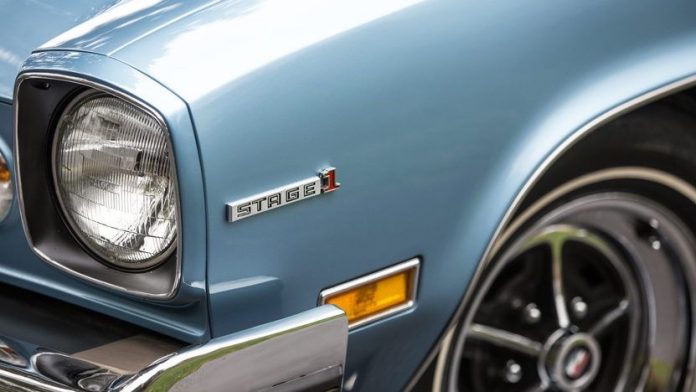









Bud Lindeamnn was a legend. Loved the long track tests and the background music with Lindemann’s dry narrative. Those were the glory days of automotive journalism. Thanks for bringing that back to us on a daily basis.
Man I laughed out loud when that thing wollowed through that 180. It reminds me of the cop cars in those old Clint Eastwood movies shot in SanFran.
The did that for effect for filming in movies and yes this car show from back then…
Always was a Buick fan. They always had nicer trim, better ride, better quality, and quieter than a Chevy. They also always had more interesting performance options. The dual quad 425 nail head in Dad’s 65 Riviera is amazing (but thirsty). My 70 GS Stage 1 convertible (factory 4 speed and bench!) was the car I most regret selling for college money. The Grand National, and lately the absolutely unnoticed supercharged 3.8’s in Rivieras and Regal GS’s. Sadly by 74 the Buick 455, king of the torque hill (at least on paper) back then was severely hobbled by almost 2 points drop in compression ratio vs my 70.
I really enjoyed that 3.8 supercharged in my many Park Ave’s. Thanks for reminding me.
One small quibble here. While you could say that the downsized 1978 model year Century had the profile of a hatchback, and a rather ungainly one at that, it was not an actual hatchback.
I remember driving one of them, or one the equally unattractive sister Olds Cutlass four doors for Driver’s Ed back in the day.
I also recall taking auto shop, and there was this girl who brought in a gold 1970 Buick GSX, which had an even more powerful 455 cubic inch engine.
Oh yeah, I meant to mention that some of us referred to that body style of Century and Cutlass as “hunchbacks” back then, and wondered what was the point of them. I mean, if they were actual hatchbacks you probably could have carried a crapload of stuff in the back.
> downsized 1978 model year Century had the profile of a hatchback, and a rather ungainly one at that, it was not an actual hatchback
That was only the “aeroback” body style. There were plenty more of ’em built with more normal body styles. My father had a ’78 Cutlass Supreme for a couple of years, and it wasn’t an aeroback (ISTR that body style being used more for the Cutlass Salon than for other Cutlass models).
Searching for “aeroback” turned up this link:
https://www.motorbiscuit.com/worst-car-wednesday-disasterous-buick-oldsmobile-1970s-gm-aerobacks/
Just like Nunzio, I was not aware that car ever existed. I started to ponder “why” the Century GS 455 was so anonymously obscure, and the reason became obvious.
That big engined beast came to market almost exactly at the same time as the 1973-74 Oil Crisis. Waiting in line for hours (and only every other day) to fill your tank quickly doused enthusiasm for big motored, heavy drinking Detroit Iron. The poor Buick was precisely in the wrong place, at the wrong time.
Got me! I’d never even heard of these!!
Kojak approves!
https://www.imcdb.org/v020015.html
Oh, what an ugly car, at least in Kojak-approved Baby Turd Brown. However, at least it was not yet another cop show with yet another FoMoCo cop car (like McGarrett and his black Merc). And, maybe Kojak’s squad had a Nailhead 425 in it…hmmm!
Hi Crusty,
As a kid, I actually met Kojak – and got his autograph!
Hey Eric!
I never could stand that arrogant Greek- I was always hoping Baretta would come along in his Gray Ghost and kick his ass 😀 – But your brush with a star certainly beats my seeing of Dom DeLouise buying a dirty magazine at a Queens newsstand (and he turns to me, offering a glance of what he was looking at, and said something like “Heyyy!” )
Who loves ya, baby?
Wow, did I just love, and still do, those 70’s boats. Obviously their engines suffered with Smog Regs, but we could remedy that easy enough today. I’ve always wanted to pick up one and re-do it, but around the rust-belt they are gone unless restored and big $, and I absolutely hate doing body work. I’m still pissed at myself when I found a 70’s 442 with 455, and in decent shape for $6K, on a trip, but i had to pass with no money to my name. I knew I would be pissed later.
To get that big today we have to go 1/2T crew cab pickup, luckily V8’s still avail., our modern boat sedans. Unfortunately, to get anything remotely luxurious like Buick, Caddy’ish, $50-60K+.
Of course there’s still the Charger/300, relatively cheap w/v8’s in the 40’s, but I would still call them mid-size, IMO.
Thanks for the memories Eric.
Lol “sofa-on-wheels-experience ” Exactly what I used to think when driving our 1988 Oldsmobile Delta 88 – except I called it driving my living room, but driving the sofa is more accurate. Big bench seat and soft cushiony ride.
The exterior developed a big white stripe down the hood, roofline and the trunk; like a skunk. This was during our South Florida years, and it was not garage parked. The interior plastic pieces fell off. But the engine was sound, oh and the brakes failed once as we were exiting the freeway; husband was driving. Good times!
I had a 1986 delta 88, and they were a sad sack shadow of the 1960-1970’s land yachts. I rode with friends and family in their 70’s Buick and Oldsmobile’s, and they were true couches on wheels, in the front and back seat. Plus rear wheel drive. The conversion to front wheel drive and major downsizing absolutely ruined these cars, but did make them more gas effective, mpg wise.
Yep, Sax,
The full-sized GM rwd cars of the 70’s and early 80’s were the best cars of their day- pretty much the only real choice if ya wanted anything decent and well-made (and not some flimsy Jap econo-box)….then they switched everything to front-wheel drive in the mid 80’s…and they were the absolute WORST!
The main problem I have with this era of design is that so many GM cars – this, the F-body, the Corvette – had read ends that were extremely low to the ground. Like a Porsche 911, which never (and still doesn’t) looked good without a whale tail.
And just like the 911, you had to get the spoiler to make them look right.
I’m totally with you on this. The cars that look good to me all have a wedge shape. The teardrop shape has never looked right to me. I don’t even like the 70s Camaro and Firebird without the big rear spoiler for the same reason. The spoiler interrupts the trailing-off rear effect. As a kid I really preferred the early 70s Mustangs over the F-bodies for that very reason. And yes, the ’74-on droopy-tail Corvette never worked for me either. Different strokes; I remember reading a car Magazine (Motor Trend, I think) covering the 74 Vette, and the writer thought the new rear treatment was a big improvement.
All that said, I didn’t know about the Buick GS in 74, and it’s pretty neat.